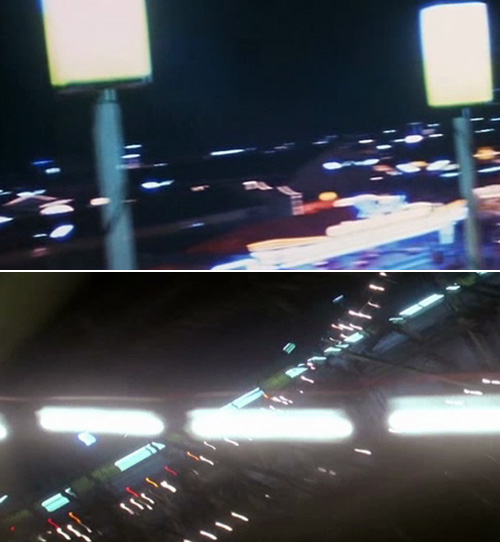Angst / Fear
Wild Horses
En el cine, los caminos de la transmisión son misteriosos. Rainer Werner Fassbinder se vio envuelto en un caso judicial relacionado con la fuente de su filme Martha (1974); el director aseguraba no recordar lo que, inconscientemente, había asimilado: un cuento de Cornell Woolrich. Parece que Fassbinder, como siempre, había digerido mucho más que ese único texto: los elementos de la breve luna de miel y del desgraciado matrimonio y las horribles quemaduras provocadas por el sol en el cuerpo de la protagonista también nos traen a la memoria El rompecorazones (The Heartbreak Kid, 1972) de Elaine May, realizada solo dos años antes. Sin embargo, aquí Fassbinder no está solo: ¿acaso no es este tipo de osmosis inconsciente, tamizada y transformadora —y mucho más rica que el frenesí intertextual, hiperconsciente y lleno de citas, practicado por Tarantino, los Coen y otros— la que está en el corazón de todo proceso verdaderamente creativo?
No sabemos si el americano James Foley, director del “thriller íntimo” Fear (1996), vio y asimiló Martha. Foley filma a sus dos amantes en un parque de atracciones de un modo sorprendentemente similar al de Fassbinder, pero esto quizás se deba, simplemente, a las exigencias y a la lógica de una historia dada y del género en que esta se inscribe. Al fin y al cabo, se trata de una situación totalmente figural: ¿de cuántas maneras se puede filmar una escena en una montaña rusa? Planos de las parejas apretujadas en el asiento, intercalados con tomas del punto de vista de los movimientos (el arranque, las subidas, las bajadas, la progresiva deceleración que conduce a la parada), y todo ello rematado por el mismo diseño de color: luminoso, llamativo, como “el interior de una jukebox” —así describió Vincente Minnelli la secuencia en el parque de atracciones de Como un torrente (Some Came Running, 1958)—. Menos habitual es que, a partir del remontaje, podamos conjurar una escena imaginaria que fusione ambas representaciones.
Sin embargo, las dos escenas entablan un intenso diálogo de ida y vuelta; sus diferencias sirven para proyectar interpretaciones, la una sobre la otra, subrayando y sacando a la luz un aspecto enterrado de su doble. No es solo que Martha, un clásico del cine de autor, ponga de manifiesto una dimensión más siniestra (y más política) del thriller popular que es Fear: de una generalización del síndrome del bad boy irresistible a una exploración del mismísimo terror del patriarcado. Quedarnos solo con este intercambio entre los dos filmes sería un acto de esnobismo. Y, además, esta metáfora ya está latente en la película de Foley (y, en general, en todo su cine).
El orgasmo virginal y adolescente de Nicole (Reese Witherspoon) bajo la hábil mano de David (Mark Wahlberg) también revela algo sobre Martha: que el angst de esta mujer (Margit Carstensen) —y sabemos cuánto le gustaba a Fassbinder colocar esta palabra en los títulos de sus películas—, este angst que le provoca el vómito una vez se ha apeado de la montaña rusa es, al mismo tiempo, una fuente perversa de placer e, incluso, de éxtasis; en unos segundos, su rostro irradiará un orgullo maníaco ante la propuesta de matrimonio que le hace Helmut (Karlheinz Böhm). Inquietante es, también, la presencia en ambas películas del mismo contrapunto: la mejor amiga de la protagonista, en segundo plano pero enfatizada por la cámara, encerrada en un abrazo ilícito y furtivo. Pero aquí hay una gran diferencia: Marianne (Barbara Valentin), la confidente de Martha, personifica a la mujer que puede manejar sus pasiones e intereses —dentro y fuera del matrimonio— como una buena burguesa, mientras Margo (Alyssa Milano), la amiga de Nicole, representa el Infierno del angst en el cual la propia protagonista ha empezado a sumergirse precipitadamente —y el dedo acusador del rudo novio de Margo sirve para masajear esa ola residual de culpabilidad postorgásmica—.
La letra del tema de los Rolling Stones (versionado aquí por The Sundays) dice: “Wild horses couldn’t drag me away”. Esta expresión idiomática inglesa significa: “Estoy tan inmersa en una pasión que nada podría distraerme o desviarme de ella”. Escuchado aquí de nuevo, tal y como es utilizado en Fear pero proyectado a través de las sombras de Martha, este tema conjura el perfecto doble vínculo psicológico de éxtasis y angst combinados: esas emociones gemelas, extremas, que se entrelazan para formar una prisión, una parálisis.
© Cristina Álvarez López & Adrian Martin, junio 2013
Wild Horses
Click para la versión en español
The paths of transmission in cinema are mysterious. Rainer Werner Fassbinder was embroiled in a legal case over the source of his film Martha (1974): he claimed not to remember what he had unconsciously absorbed, a story by Cornell Woolrich. As always, he seems to have absorbed much more than this one text: the elements of brief honeymoon, bleak marriage and hideous sunburn in Martha also irresistibly evoke Elaine May’s The Heartbreak Kid (1972) from two years previously. But Fassbinder was not unique here: isn’t every truly creative process this kind of sifting and transforming, unconscious osmosis – a richer vein by far than the hyper-conscious, quotational frenzy of intertextuality we associate with Tarantino, the Coens, et al?
It is not documented whether James Foley, director of the American ‘intimacy thriller’ Fear (1996), saw and absorbed Martha. Perhaps it was simply the demands and logic of his given story and genre that led him to shoot his fairground ride, involving two new lovers, in a way uncannily similar to Fassbinder. It is, after all, a properly figural situation: how many ways are there to film such a Big Dipper scene? Shots of the couple bunched close together in the seat, alternating with POV shots of the movement: setting off, climbing up, plunging down, slowing down to a halt … complete with the same luminous, garish colour scheme (like ‘the inside of a jukebox’, as Vincente Minnelli once said of his fairground scene in Some Came Running, 1958). More than usually, it is possible to conjure, through montage, an imaginary scene that fuses both depictions.
Yet the two scenes enter into an intense dialogue, back and forth; their differences serve to project interpretations, one into the other, each film underlining and bringing out a buried aspect of its double. It is not only the case that Martha, an art-film classic, reveals a more sinister (and more political) dimension in the popular, genre thriller that is Fear – a generalisation of the ‘charming bad boy’ syndrome into an exploration of the terror of patriarchy itself. To rest on merely that exchange between the two films would just be snobbery; and besides, this metaphor is already latent throughout much of Foley’s film (and his cinema, in general).
The virginal, teenage orgasm of Nicole (Reese Witherspoon), under the deft hand of David (Mark Wahlberg), also reveals something about Martha: that the angst of this woman (Margit Carstensen) – and we know how fond Fassbinder was of placing this word angst in his film titles – this angst which makes her vomit after the ride is over is also a perverse source of pleasure, even ecstasy, for her; in just a moment she will be beaming with manic pride at the marriage proposal she receives from Helmut (Karlheinz Böhm). Uncanny, too, is the presence in both films of the same counterpoint: the best friend of the female protagonist in the background but emphasised by the camera, locked in an illicit, furtive embrace. But a big difference here: where Martha’s confidante Marianne (Barbara Valentin) stands for the woman who can ‘manage’ her passions and interests (marital and extra-marital) like a good bourgeois, Nicole’s gal pal Margo (Alyssa Milano) represents the Hell of angst into which Nicole herself is plunging, headlong – with the pointed, accusing finger of the rough boyfriend serving to massage a residual wave of post-orgasmic guilt.
The Rolling Stones song (here covered by The Sundays) chants: wild horses couldn’t drag me away. In English, the idiomatic expression means: I am so passionate about the situation I’m in, nothing could distract me or divert me from it. Heard again here, as used in Fear but now projected through the shadow of Martha, it conjures the perfect psychological double bind of ecstasy and angst combined: these twin, extreme emotions knot to form a prison, a paralysis.
© Cristina Álvarez López & Adrian Martin, June 2013

